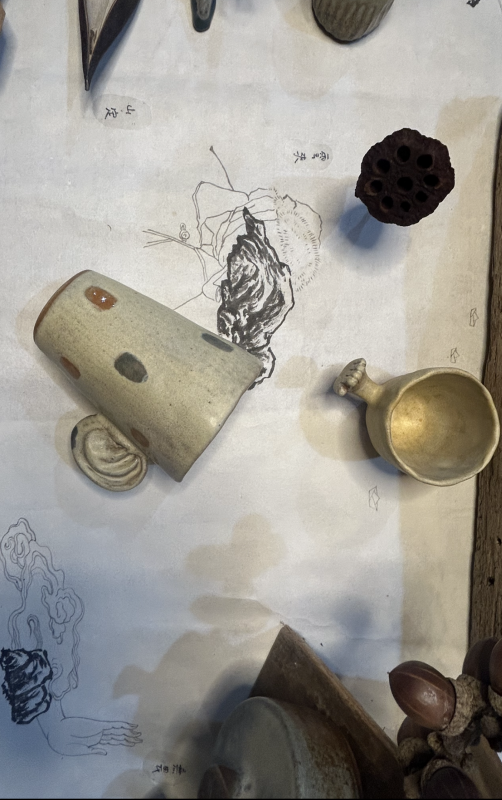- The Dark Filter of Sound: Timestretching, Eroticism and Reification
- Sound Characters: A Prolegomena to a Concept
- My Constant Companion: A Tinnitus Tale
- The Worker Bee
- Now That’s What I Call Girl Talk
-
- An ear made of soap, 2017, one of about ten others on a store shelf next to some soap sheep, angels, leaves, flowers, Santa Clauses, mother Mary, skulls, frogs, other beautiful soaps in Condesa, CDMX. My friend C. purchases it — oh no, they only photograph it. I ask them for the photo a year later, they send it and my cofounder Ashley Chaney and I crop the ear out for the first logo of this publication (still our instagram profile image.)
- Another soap ear — this time one that friend, collaborator, and talented ceramicist Jeanie Lee casts from a mould made on my right ear—actually eventually it’s 50 or so of them of different colors. When stored, they start to sweat glycerin. We sold several, didn’t raise too much money, though, for either Soap Ear or for Jeanie’s vision and efforts beyond the cost of supplies. The Issue 6 cover image that she shoots lays them out, technicolored on white. Later she makes a GIF of water running over a blue soap ear in a hand built and pump-installed ceramic fountain, This loops over the cover of issue 7.
- A ceramic ear my bud K gives me for my 31st birthday. I decide to pin it on my shirt while I am substitute teaching here in New York City, a mark and a welcoming gesture — also as Lele points out, quite grotesque.
- Another ceramic ear this one protruding from the side of a hand thrown mug displayed at a crafts fair in Hualien, Taiwan, by artist 嶼人淘陶 (Yǔ Rén Táo Táo) who also made a ceramic pin I’d already purchased for a friend at a gift shop the day before. I join K’s conversation with this artist who proceeds to explain that the mug was made as a Van Gogh reference. I think that when saying ‘Van Gogh’, she must be saying ‘ear’ in Mandarin. K helps me to propose an impromptu photo shoot right there for the new issue’s cover image.
- A Soap Ear return issue, again, this time after a 3 year hiatus, comprised of several articulations and testaments to life’s jagged beautiful unraveling, entangled with the nearly but never at all unspeakable public violences of and between nation-states on non-sovereign and sovereign subjects. Here, there. Guest editor Sunik Kim helps me pull it all together while co-editor Leah B. Levinson is on tour. The uncertainties and steady instability of our refusals, meanders, and growth in and across communities, scenes, projects of various scales, whether to make do or else flourish in bright wreckage, where skies are found open.
- In the issue:
- Vincent Jenewein’s article charting an understanding of timbre by whatever perceptual character or descriptors fit them, that sound really is what we make of it, socially and individually, as abstract or simple as we characterize it. That this phenomenalist alignment constitutes not some academic sound studies field but an entire horizon.
- Josephine Ingram Defaye’s poem of a buzzing working-girl, trans bumblee, riding the city bus feeling beautiful (in)attention, ire, jealous looks, and other dull ecstasies.
- CM Gorey’s essay about adjusting to, living, and working as a musician and audio mixer with chronic tinnitus.
- Now That’s What I Call Girl Talk, Lyle Daniel and Arthur Sillers’ mixtape, mashing up 2000’s feel good hits, reality dating show samples, and today’s various RnB and trap jitters, within the continual collisions of compulsion that make up this pop-scape.
- Sunik Kim’s article tracing the homo-eroticism and dereifying gendered experience by the use of timestretching in one opera, three dancefloor tracks, one book, and three films
- Our ears, yours — skin, blood vessels, cartilage, + — ears which have been hearing and/or listening, an (in)attentive process with some highlights and some perturbations. They (you) can’t speak while listening, and so perhaps later on you (they) nudge the hand to scribble something down that was heard.
- A ceramic hand extending out from another mug next to the ear mug, possibly suggesting pause, contemplation, reach, welcome, strength, awareness, touch, resistance, growth, there amidst the makeshift, arranged scene of our photo-shoot, disassembled again shortly after the image was taken, rearranged back into a functional arts-fair stand. What our respective, collected hands have managed and also felt over the last three years between Soap Ear issues; and in the ten years since Soap Ear began. What they haven’t, won’t, and still will.
– Lyle Daniel, Soap Ear Co-Editor. October, 2024.
